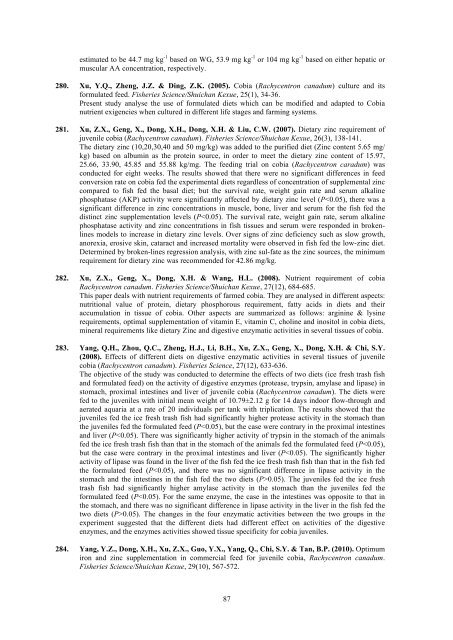COBIA (Rachycentron canadum)
4tEewMrkr
4tEewMrkr
- No tags were found...
Create successful ePaper yourself
Turn your PDF publications into a flip-book with our unique Google optimized e-Paper software.
estimated to be 44.7 mg kg -1 based on WG, 53.9 mg kg -1 or 104 mg kg -1 based on either hepatic ormuscular AA concentration, respectively.280. Xu, Y.Q., Zheng, J.Z. & Ding, Z.K. (2005). Cobia (<strong>Rachycentron</strong> <strong>canadum</strong>) culture and itsformulated feed. Fisheries Science/Shuichan Kexue, 25(1), 34-36.Present study analyse the use of formulated diets which can be modified and adapted to Cobianutrient exigencies when cultured in different life stages and farming systems.281. Xu, Z.X., Geng, X., Dong, X.H., Dong, X.H. & Liu, C.W. (2007). Dietary zinc requirement ofjuvenile cobia (<strong>Rachycentron</strong> <strong>canadum</strong>). Fisheries Science/Shuichan Kexue, 26(3), 138-141.The dietary zinc (10,20,30,40 and 50 mg/kg) was added to the purified diet (Zinc content 5.65 mg/kg) based on albumin as the protein source, in order to meet the dietary zinc content of 15.97,25.66, 33.90, 45.85 and 55.88 kg/mg. The feeding trial on cobia (<strong>Rachycentron</strong> caradum) wasconducted for eight weeks. The results showed that there were no significant differences in feedconversion rate on cobia fed the experimental diets regardless of concentration of supplemental zinccompared to fish fed the basal diet; but the survival rate, weight gain rate and serum alkalinephosphatase (AKP) activity were significantly affected by dietary zinc level (P


